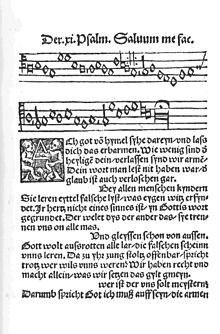| "Ach Gott, vom Himmel sieh darein" | |
|---|---|
| Hymn by Martin Luther | |
 | |
| English | Oh God, look down from heaven |
| Catalogue | Zahn 4431–4432a |
| Text | by Martin Luther |
| Language | German |
| Published | 1524 |
"Ach Gott, vom Himmel sieh darein" ("Oh God, look down from heaven") is a Lutheran chorale of 1524, with words written by Martin Luther paraphrasing Psalm 12. It was published as one of eight songs in 1524 in the first Lutheran hymnal, the Achtliederbuch, which contained four songs by Luther, three by Speratus, and one by Justus Jonas. It was contained in 1524 in the Erfurt Enchiridion. It is part of many hymnals, also in translations. The text inspired vocal and organ music by composers such as Heinrich Schütz, who set it as part of his Becker Psalter, and Johann Sebastian Bach, who based a chorale cantata on it. Mozart used one of its tunes in his opera The Magic Flute . [1]
